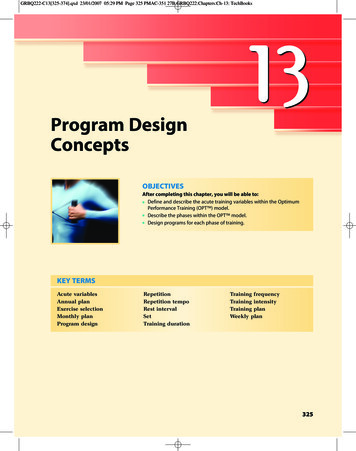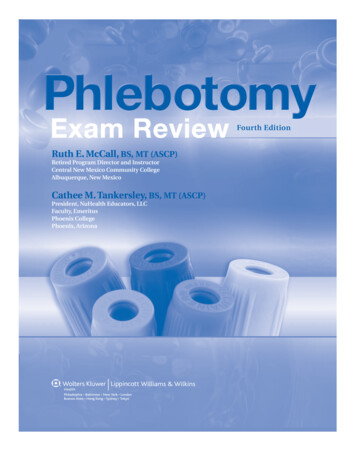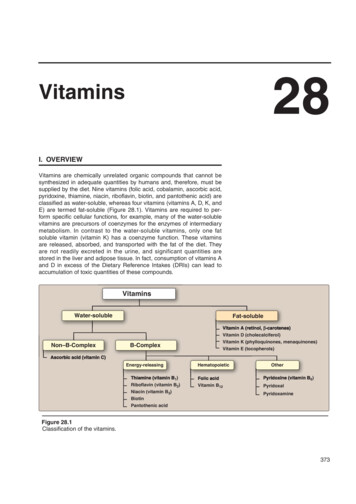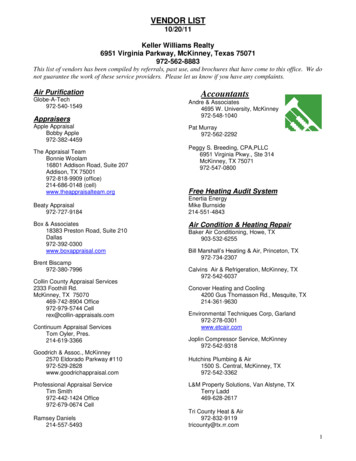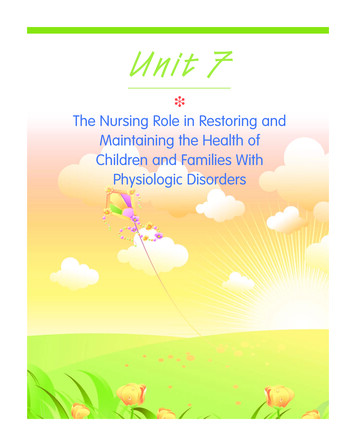
Transcription
15610 Ch40.qxd5/7/094:58 AMPage 1135Unit 7d The Nursing Role in Restoring andMaintaining the Health ofChildren and Families WithPhysiologic Disorders
15610 Ch40.qxd5/7/094:58 AMPage 1137Chapter40K E Y Nursing Care of a Family When aChild Has a Respiratory DisorderMichael is a 4-year-oldT E R M Sadventitious soundsanoxiaarterial blood onhypoxemiahypoxiainspirationparoxysmal coughing zingO B J E C T I V E SAfter mastering the contents of this chapter, you should be able to:1. Describe common respiratory disorders in children.2. Identify National Health Goals related to children with respiratorydisorders that nurses could help the nation achieve.3. Use critical thinking to analyze ways nursing care for a child with arespiratory disorder could be more family centered.4. Assess a child with a respiratory disorder.5. Formulate nursing diagnoses related to respiratory disorders inchildren.6. Identify expected outcomes that address the priority needs of achild with a respiratory disorder.7. Plan nursing care for a child with a respiratory disorder.8. Implement nursing care for a child with a respiratory disorder suchas administering oxygen to a child.9. Evaluate expected outcomes for achievement and effectiveness ofcare.10. Identify areas related to care of children with respiratory disordersthat could benefit from additional nursing research or application ofevidence-based practice.11. Integrate knowledge of respiratory disorders in children with nursingprocess to achieve quality maternal and child health nursing care.who is brought to theemergency department by paramedicsafter responding to an emergency callby his grandmother at his home. Hehas a sharp, barking cough, is cryingloudly, and is obviously short ofbreath. “He can’t breathe!” his grandmother shouts at you. “I gave himsome chocolate. Is he allergic to that?”his grandmother asks. Michael is diagnosed as having laryngotracheobronchitis (croup) and admitted to an ambulatory care unit.Previous chapters described thegrowth and development of well children. This chapter adds informationabout the dramatic changes, bothphysical and psychosocial, that occurwhen children develop respiratorydisorders.What emergency care does Michaelneed? What about Michael’s action wouldlead you to believe his airway is not yetcompletely obstructed?1137
15610 Ch40.qxd11385/7/094:58 AMPage 1138UNIT 7 The Nursing Role in Restoring and Maintaining the Health of Children and Families With Physiologic DisordersRespiratory disorders are among the most commoncauses of illness and hospitalization in children. Overall, respiratory dysfunction in children tends to be more seriousthan in adults because the lumens of a child’s respiratorytract are smaller and therefore more likely to become obstructed. Because respiratory disorders range from minor illnesses such as a simple upper respiratory tract infection tolife-threatening lower respiratory tract diseases, such aspneumonia, and because the level of acuity can changequickly, respiratory disorders are often difficult for parentsto evaluate. Both a child and parents need a great deal ofnursing support when disease interferes with the function ofbreathing, because even very young children can panic whenbreathing becomes labored. Early diagnosis and treatmentare essential in preventing a minor problem from turninginto a more serious one (Merelle et al., 2009).Because respiratory disorders are such a common cause ofchildhood illness and hospitalization, National Health Goalshave been established for children with respiratory illnesses(Box 40.1).BOX 40.1 Focus onNational Health GoalsSeveral National Health Goals focus on respiratory illness in children: Reduce the rate of asthma deaths in children aged 5to 14 years from a baseline of 3.3 per million to a target level of 0.9 per million. Reduce the rate of hospital emergency departmentvisits for children with asthma younger than 5years from a baseline of 150 per 10,000 to 80 per10,000. Reduce the rate of cigarette use by adolescentsfrom a baseline of 35% to a target of 16%; cigar usefrom 18% to 8%, oral tobacco use from 8% to 1%,and bidis use from 4% to 2%. Reduce the incidence of invasive pneumococcal infections in children younger than 5 years from abaseline of 76 per 100,000 to a target of 46 per100,000. Reduce the incidence of tuberculosis from a baselineof 6.8 per 100,000 cases yearly to a target level of 1.0per 100,000 (http://www.nih.gov).Nurses can help the nation achieve these goals byteaching children to avoid beginning cigarette smoking, including the use of bidis (chocolate-flavored tobacco products), teaching children ways to help avoidrespiratory infections such as good handwashing, andreminding parents to come for child health maintenance visits so that children can receive pneumococcal immunization or screening for tuberculosis, asappropriate.Additional nursing research is needed about the accuracy of parents in self-reading and interpreting tuberculosis screening tests and information required by newparents to better manage respiratory illness in infantsand young children.Nursing Process OverviewFor a Child With a Respiratory DisorderAssessmentRespiratory illness can begin as early as moments afterbirth if a newborn has difficulty initiating a first breath orestablishing regular respirations. Rating a newborn usingan Apgar score can help to quickly identify a newbornwho may be experiencing respiratory difficulty at thisearly stage.As a nurse in an emergent care or health maintenanceorganization, you are often the first health care provider totalk to a parent about a child’s respiratory illness. It is important to establish both the onset and duration of theproblem so that its seriousness can be rapidly determined.An episode of sudden coughing is suggestive of an acuterespiratory disorder. Infants who cannot finish a bottlefeeding because of exhaustion or rapid breathing or children who cannot run with other children because they donot have enough breath should be suspected of having achronic respiratory disorder.A child admitted to the hospital with a respiratory disorder is usually in an acute stage of the illness. A child’scondition may worsen rapidly in the first few hours untila prescribed medication, such as an antibiotic or bronchodilator, begins to take effect. Nursing assessment thata child is developing tachypnea or retractions may be thefirst indication of a child’s worsening condition.Nursing DiagnosisNursing diagnoses established for children with respiratory disorders focus both on the alteration in mechanisms of breathing and on the emotional distress suchproblems can create. “Ineffective airway clearance” is acommon diagnostic category used in this area. Theproblem may be related to any one of a variety of factors,such as ineffective cough, fatigue, weakness, viscous secretions, pain, aspiration (inhalation of a foreign objectinto the airway), or lack of knowledge about the importance of coughing.The diagnostic categories “Impaired gas exchange” and“Ineffective breathing pattern” also may be used, althoughbecause a nurse does not generally prescribe definitivetreatment for these problems (except when caused by hyperventilation), it may be more appropriate for a nursingdiagnosis to focus on the effects of impaired gas exchangeor ineffective breathing on daily activities and psychosocial health. Examples of nursing diagnoses are: Activity intolerance related to insufficient oxygenationFatigue related to impaired gas exchangeFear related to inability to breathe without effortImpaired social interaction related to difficulty inkeeping up with physical activities of peers Deficient knowledge related to need for continuedtreatmentOutcome Identification and PlanningIf a child is experiencing an acute respiratory problem, theexpected outcomes and plan of care will focus on supporting the child and family through prescribed therapy and
15610 Ch40.qxd5/7/094:58 AMPage 1139CHAPTER 40 Nursing Care of a Family When a Child Has a Respiratory Disorderkeeping parents informed about their child’s health statusand response to treatment. Often the treatment period forrespiratory illness is prolonged, so parents of children withchronic conditions need to learn how to continue therapyat home. Helping parents to plan programs of exercise andteaching chest physiotherapy and the actions of prescribedmedications are important nursing activities. Parents alsoneed to understand that their approach to these programsmust change as their child grows older. With an infant,they simply need to perform the prescribed procedures. Agame might be a good way to get a toddler or preschoolerto breathe deeply (“Simon says, cough. Simon says, takefive deep breaths”). Parents need to plan exercise programsfor school-age children and adolescents around theirschool day. Otherwise, children may have difficulty carrying out the program or carry it out only sporadically. Ifparents include other family members, such as older siblings (within reason) or grandparents, in a respiratory therapy program, this can help to diffuse the burden of careand also to unite the family in working toward a commongoal. Helpful Web sites for parents to consult aboutrespiratory illnesses are http://www.kidshealth.org andhttp://www.everydayhealth.com. Some organizations torecommend as support to parents of the child with a respiratory disorder include American Lung Association(http://www.lungusa.org), National Asthma Educationand Prevention Program (http://www.nhlbi.nih.gov),National Easter Seal Society (http://www.easterseals.com),and Cystic Fibrosis Foundation (http://www.cff.org).ImplementationCollaborative nursing interventions in the care of a childwith respiratory dysfunction include suctioning to removerespiratory secretions, administering oxygen, and providing humidification and expectorant therapy to help maintain clear airways. Some of the most important nursinginterventions in this area are independent nursing functions: placing a child in an upright position to help thechild cough more effectively; providing an interestinggame to teach a child the importance of strengtheningchest muscles; supporting a child and family through theanxiety created when a child is not breathing normally;and teaching parents of a child with chronic respiratorydysfunction the basics of percussion or chest physiotherapytechniques. All of these interventions require sound nursing judgment and skill to carry out or teach effectively.Outcome EvaluationAn acute respiratory illness such as pneumonia is extremely frightening for parents as well as the child. Afterthe child has recovered, talk with the parents to determinewhether they have come to terms with their fear and cantreat the child as a well child again. Otherwise, overprotection of a child by the parents may result in a well butdependent child. This pattern is one that nursing evaluation can help to prevent.Expected outcomes for a child with chronic respiratorydisease will change as a child grows and develops. No matter what the specific concerns are, however, evaluationshould always include examination of how well a childindividually and the family as a whole have adapted tomanaging the limitations imposed by the disorder while1139maintaining a lifestyle that fosters growth and development for all family members.Examples of expected outcomes that would indicateachievement of goals are: Infant, at 3 months, maintains respiratory rate of atleast 30 breaths per minute. Child describes a reduced program of school activitieshe will maintain to reduce fatigue. Child’s PO2 is maintained at 80 to 100 mm Hg inroom air. Child lists steps she will take if breathing becomes impaired while at school. Parents demonstrate correct techniques for performingrespiratory therapy at home. ANATOMY AND PHYSIOLOGY OF THERESPIRATORY SYSTEMThe respiratory system can be separated into two divisions:the upper respiratory tract, composed of the nose, paranasalsinuses, pharynx, larynx, and epiglottis; and the lower tract,composed of the bronchi, bronchioles, and alveoli. Throughinspiration (breathing in), the respiratory system deliverswarmed and moistened air to the alveoli, transports oxygenacross the alveolar membrane to hemoglobin-laden red bloodcells, and allows carbon dioxide to diffuse from red bloodcells back into the alveoli. Through expiration (breathingout), carbon dioxide–filled air is discharged to the outside.Levels of oxygen and carbon dioxide in the lungs, blood, andbody cells are shown in Figure 40.1.The respiratory center is located in the medulla of thebrain. Peripheral receptors located in the aortic arch andcarotid arteries sense diminished PO2 levels and respond byincreasing the respiratory rate. Central respiratory receptorsin the medulla sense increased PCO2 levels along with bodyacidity, temperature, and blood pressure as another stimulusto respiration. Depth of respiration is influenced by proprioceptors located in the lung periphery that register lungfullness. An inhibitory center in the pons halts inspiratoryimpulses before the lungs become overextended. Often children with chronic lung disease such as cystic fibrosis haveadapted so well to a chronically high PCO2 level that centralreceptor sites no longer register this as abnormal. In these instances, the main stimulus for respiration is a low oxygenlevel. In such children, administering high levels of oxygencan be dangerous because it alleviates oxygen want or theirmain respiratory stimulus.Respiratory Tract Differences in ChildrenEmbryologic development of the respiratory tract is discussed in Chapter 9. Because the respiratory tract continuesto mature during childhood, children have several importantdifferences in respiratory anatomy and physiology thanadults. The
“Ineffective airway clearance” is a common diagnostic category used in this area. The problem may be related to any one of a variety of factors, such as ineffective cough, fatigue, weakness, viscous se-cretions, pain, aspiration (inhalation of a foreign object into the airway), or lack of knowledge about the impor-tance of coughing. The diagnostic categories “Impaired gas exchange” and .
